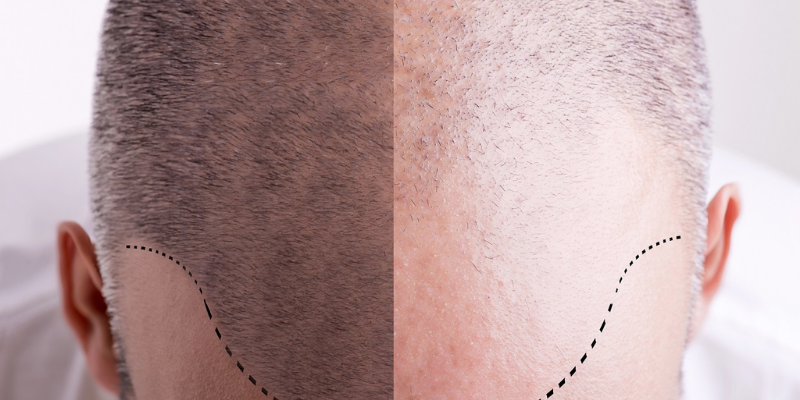Can I wear skull cap after hair transplant? Hair loss can hurt your self-esteem and self-confidence. Hair transplant clinics understand this and support all patients to help you regain your trust. When it comes to hair transplants, one of the most often asked concerns is whether or not a cap may be worn following the procedure.
Sometimes, men and women seek out surgical hair loss treatments without giving much thought to the recuperation period. After a hair transplant, it is natural to feel ashamed or uncomfortable. Are there any dangers in covering one’s head in order to avoid unwanted attention or insensitive questions? It’s not safe at all.
Can I Wear Skull Cap After Hair Transplant
It is possible to treat male pattern baldness with a long-term, natural treatment through hair transplantation surgery. It’s a straightforward surgical technique to transplant hair follicles taken from parts of the scalp that still have hair into thin or bald areas.
In order to protect the implants from the face while they are healing, you may wish to wear a helmet or skull cap following surgery, but if feasible, avoid wearing one, since your skin will recover quicker if exposed to air. Consider wearing a baseball cap or other loose-fitting headgear with holes to let your skin breathe.
Why Do Patients Want to Wear Skull Cap After Hair Transplantation?
Many individuals believe that hair transplantation is a straightforward operation. After hair transplantation, many people believe that everything would be OK, but this is not the case. Following the operation, there are more things to consider than during the procedure. There are numerous things to consider when undergoing a medical treatment such as hair transplantation. Nutrition, athletics, avoiding unhealthy habits, physical protection and contact are only few of the factors to consider. I wonder if you can wear a hat in the snow.
As a result, they are trying to conceal the hair transplant procedure. A hat is frequently worn by patients who want to shave their heads and cover the redness in the transplanted regions as a result of the procedure. Modern hair transplantation procedures do not need shaved hair, thus a hat is not necessary. Because the patients will not be disturbed by the look.
There are no visible red scars when there is no need to open a hair root canal on the scalp, either. That you don’t look like you’ve undergone hair transplant surgery is also a big plus.
During the time it takes for the transplanted hair to grow, it is preferable to wear a hat that is not too harsh or too tight.
Healing Process After Hair Transplantation : Can I Wear Skull Cap After Hair Transplant
After hair transplantation, the grafts must settle in for at least one week. The grafts must be well placed. Contact with the hair transplant area should be avoided. For the worst case scenario, pressing on this location might cause the grafts to be compressed and dislodged. After the surgery, wearing the hat, which may induce adverse symptoms, is quite risky. It is possible for the surgery to be hampered by wearing a hat after hair transplantation.
There should be no interaction with the treated area for at least 48 hours. Hats that do not contact the hair transplant region and are approved by your doctor can be worn to help protect it. So that the top of the cap does not bend and contact the planting area, hats can be worn that are firm on top. There should always be a space between the cap and the planting area, and the cap should never contact the planting area. – Hats like golf and safari hats can be worn.
The hats that are intended for hair transplantation procedures are available in several hair transplant clinics. They allow those who have undergone a hair transplant and are worried about the resultant appearance to continue their social life without having to worry. Meanwhile, hair transplants performed in the summer are shielded from the sun and intense heat owing to these caps, which are made particularly for this region.
How Many Days After Hair Transplant Skull Cap Is Worn?: Can I Wear Skull Cap After Hair Transplant
How soon after a hair transplant may I wear a hat? For the first few days after hair transplantation, the scalp may expand and you may have bleeding and crusting. To disguise the hair growth, you may find it convenient to cover your scalp at this period. To ensure that the grafts are securely attached, doctors recommend waiting 7 to 10 days before adding anything else to the scalp. Hats might increase the risk of grafts being pinched, damaged, or dislodged during a graft implantation procedure.
Graft damage may result in hairless areas on the scalp, compromising the overall healing process. The grafts are firmly connected after 7-10 days, at which point a hat can be worn. Even while hair transplantation might give you a new look, it can also give you an unsettling aspect. In order to conceal their scalps following hair transplantation, the majority of patients turn to various means of camouflage. Waiting at least 10 days before wearing a hat or other head accessories is recommended by your surgeon For those who still desire a cap or hood, your surgeon will prescribe one that is loose and readily adjustable. Avoid putting on or taking off clothes that need you to go above your head. Rather, choose for shirts that have zippers or buttons up the front.
Why Is It Inconvenient To Wear Skull Cap After Hair Transplantation?
When it comes to hair transplant root loss, wearing a beret, a skull cap, or hitting and stroking a low spot is the worst. As soon as the roots begin to develop or are injured, quick action is required. There’s no way to undo that because he’s on his own at that point in time. Root survival is extremely unlikely even if the patient gathers the roots and brings them. It is, therefore, crucial to pay close attention to the first three days following surgery.
You can wear a hat three days following surgery, then a beret for a week. If the patient believes that nothing will happen, they may decide to wear a cap or beret instead of waiting.
African American Hair Transplant Before After Comparison
The results of African American hair transplant before after comparison reveal a remarkable transformation. A successful African American hair transplant procedure can have a positive impact on an individual’s confidence and overall well-being. By seeing how effective their transplant was, many patients are encouraged to take greater ownership of their appearance and overall health. They may feel more comfortable with trying new styles or activities that they might not have previously considered due to insecurity about their hair loss. Additionally, many patients report feeling more attractive and confident after undergoing a hair transplant procedure as they feel more like “themselves” again.

With improved self-confidence comes higher levels of satisfaction in life and better mental health in general, all benefits that can be seen through an African American hair transplant before after comparison. Overall, the results of an African American hair transplant surgery can be extremely satisfying for individuals who have experienced hair loss due to various causes such as hereditary balding or medical conditions. Following closely recommended instructions for post-operative care and follow-up visits can help ensure that the desired results last for many years, even decades into the future.



